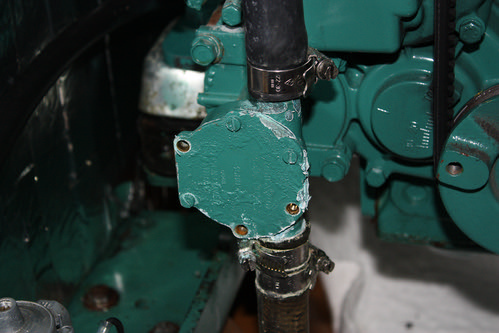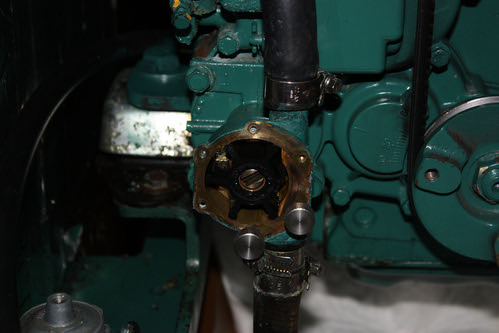I can tell that you are excited.
Underneath our cockpit is our 29HP diesel engine, a Volvo MD2030D.

Our impeller is what moves sea water through our engine which passes around tubes of coolant and cools the coolant so it, in turn, can cool the engine. This is called a heat exchanger and works the same as your radiator in your car except your radiator uses air.
The impeller lives inside the raw water pump and should be checked regularly. The housing for it is not terrible to open but not exactly a "pre-sail" check. Plus, we generally would have to replace a paper gasket because it tears AND you have to shut off the sea water intake (raw water = sea water) so you don't flood your boat.

The impeller itself looks like a black rubber asterisk. Ours had one blade torn in half and two others cracking. They can still move a fair amount of water when damaged but if they stop, you overheat and when they blow up into bits, those bits get into your heat exchanger and plug it and generally become a PITA. If you look closely you can see the torn blade (clicking on the photo might help if you want a larger size).

What you can also see in the photo above is a new pump cover with an o-ring instead of a paper gasket. After inserting a new impeller (or after checking an old one) there are two guide screws that are left inside the pump.

After sliding the cover onto the guide screws and hand tightening those, you insert two other screws, also hand tightened with etched sides that make them easy to handle even when wet.

We can now check our impeller as easily as we can reach the raw water shut off...which is still a wee pain, but much, much less of a pain now. And if I have learned anything about maintenance it is that easy tasks get done and annoying tasks are easy to push off.
Now, complete honesty. We are right on time with all of our other engine maintenance, but we have *never* checked our impeller before this haul out. And, after reading the detailed log kept by the previous owner, I don't know if he ever checked it either. This would mean that the impeller inside was original, from 2004 and had 730 engine hours...and it was cracking...and the gasket was completely decomposed.







I've seen these advertised and always passed them by. But as you point out, "easy tasks get done and annoying tasks are easy to push off."
ReplyDeleteI'm going to do what you did: Make this an easy task.
Thanks!
bob
Wow - that is turning out to be harder than I thought... From whom did you purchase yours?
ReplyDeleteAnd while I am asking, from what material are the screws made?
bob
Oh, I am so going to get one of those. I forgot what a nightmare it was to open our water pump to change impellers until you reminded me. Thanks. -Steve
ReplyDelete@Bob - I got ours from here: http://www.speedseal.com/Pages/usaprices.htm
ReplyDeleteAnd they say 316 marine stainless on the specs page: http://www.speedseal.com/Pages/techdetails.html
Timely ... we just changed the one in our CS36 to find out that one of its arm's was broken. New impellor in now but now the seals leak ...
ReplyDeleteX
We've been using a Speedseal cover for the past three years. It really is a great product - simplier to inspect and replace the impeller, and IMHO it provides a better seal than the paper gaskets. Wonderful blog and cruising project website - keep up the good work.
ReplyDeleteSVCarolena
I would love to have something like this with a small window through which I could observe the rotation of the impeller (or lack thereof).
ReplyDelete